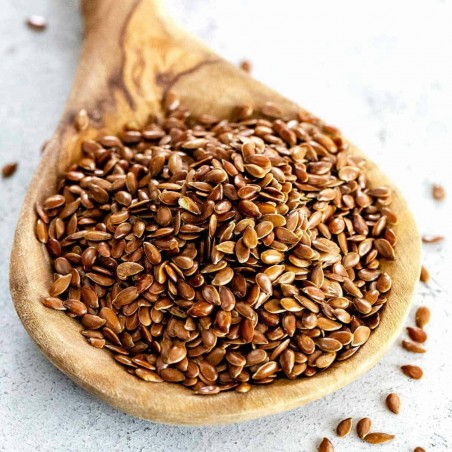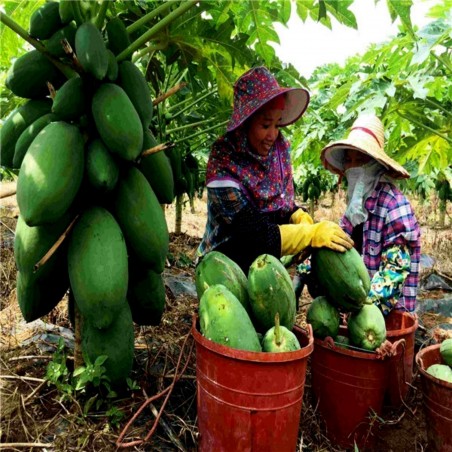
Spice Flax medicinal and healthy
Flax medicinal and healthy
The price is for packaging of 10 grams of this spice.
Flax (Linum usitatissimum), also known as common flax or linseed, is a member of the genus Linum in the family Linaceae. It is a food and fiber crop cultivated in cooler regions of the world. The textiles made from flax are known in the Western countries
Flax medicinal and healthy
The price is for packaging of 10 grams of this spice.
Flax (Linum usitatissimum), also known as common flax or linseed, is a member of the genus Linum in the family Linaceae. It is a food and fiber crop cultivated in cooler regions of the world. The textiles made from flax are known in the Western countries as linen, and traditionally used for bed sheets, underclothes, and table linen. The oil is known as linseed oil. In addition to referring to the plant itself, the word "flax" may refer to the unspun fibers of the flax plant. The plant species is known only as a cultivated plant, and appears to have been domesticated just once from the wild species Linum bienne, called pale flax.
Several other species in the genus Linum are similar in appearance to L. usitatissimum, cultivated flax, including some that have similar blue flowers, and others with white, yellow, or red flowers. Some of these are perennial plants, unlike L. usitatissimum, which is an annual plant.
Cultivated flax plants grow to 1.2 m (3 ft 11 in) tall, with slender stems. The leaves are glaucous green, slender lanceolate, 20–40 mm long, and 3 mm broad.
The flowers are pure pale blue, 15–25 mm in diameter, with five petals. The fruit is a round, dry capsule 5–9 mm in diameter, containing several glossy brown seeds shaped like an apple pip, 4–7 mm long.
Flax is grown for its seeds, which can be ground into a meal or turned into linseed oil, a product used as a nutritional supplement and as an ingredient in many wood-finishing products. Flax is also grown as an ornamental plant in gardens. Moreover, flax fibers are used to make linen. The Latin name of the species, usitatissimum, means "most useful".
Flax fibers taken from the stem of the plant are two to three times as strong as cotton fibers. Additionally, flax fibers are naturally smooth and straight. Europe and North America both depended on flax for plant-based cloth until the 19th century, when cotton overtook flax as the most common plant for making rag-based paper. Flax is grown on the Canadian prairies for linseed oil, which is used as a drying oil in paints and varnishes and in products such as linoleumand printing inks.
Linseed meal, the byproduct of producing linseed oil from flax seeds, is used to feed livestock. It is a protein-rich feed for ruminants, rabbits, and fish.
A 100-gram portion of ground flaxseed supplies about 534 calories (2,230 kJ), 41 g of fat, 28 g of fiber, and 20 g of protein.
Flaxseed sprouts are edible and have a slightly spicy flavor profile. Excessive consumption of flaxseeds with inadequate amounts of water may cause bowel obstruction. In northern India, flaxseed, called tisi or alsi, is traditionally roasted, powdered, and eaten with boiled rice, a little water, and a little salt. In India, linseed oil is known as alsi in Hindi and javas in Marathi. It is mainly used in Savji curries, such as mutton (goat meat) curries.
Whole flaxseeds are chemically stable, but ground flaxseed meal, because of oxidation, may go rancid when left exposed to air at room temperature in as little as one week. Refrigeration and storage in sealed containers will keep ground flaxseed meal for a longer period before it turns rancid. Under conditions similar to those found in commercial bakeries, trained sensory panelists could not detect differences between bread made with freshly ground flaxseed and bread made with flaxseed that had been milled four months earlier and stored at room temperature. This shows, if packed immediately without exposure to air and light, milled flaxseed is stable against excessive oxidation when stored for nine months at room temperature, and under warehouse conditions, for 20 months at ambient temperatures.
Three natural phenolic glucosides—secoisolariciresinol diglucoside, p-coumaric acid glucoside, and ferulic acid glucoside—can be found in commercial breads containing flaxseed.
Flax fiber is extracted from the bast beneath the surface of the stem of the flax plant. Flax fiber is soft, lustrous, and flexible; bundles of fiber have the appearance of blonde hair, hence the description "flaxen" hair. It is stronger than cotton fiber, but less elastic. The best grades are used for fabrics such as damasks, lace, and sheeting. Coarser grades are used for the manufacturing of twine and rope, and historically, for canvas and webbing equipment. Flax fiber is a raw material used in the high-quality paper industry for the use of printed banknotes, laboratory paper (blotting and filter), rolling paper for cigarettes, and tea bags.
The use of flax fibers dates back tens of thousands of years; linen, a refined textile made from flax fibers, was worn widely by Sumerian priests more than 4,000 years ago. Industrial-scale flax fiber processing existed in antiquity. A Bronze Age factory dedicated to flax processing was discovered in Euonymeia.
Flax mills for spinning flaxen yarn were invented by John Kendrew and Thomas Porthouse of Darlington, England, in 1787. New methods of processing flax have led to renewed interest in the use of flax as an industrial fiber.
One study of research published between 1990 and 2008 showed that consuming flaxseed or its derivatives may reduce total and LDL-cholesterol in the blood, with greater benefits in women and those with high cholesterol.
A meta-analysis has shown that consumption of more than 30 g of flaxseed daily for more than 12 weeks reduced body weight, body mass index (BMI), and waist circumference for persons with a BMI greater than 27. Another meta-analysis has shown that consumption of flaxseed for more than 12 weeks produced small reductions in systolic blood pressureand diastolic blood pressure Flaxseed supplementation showed a small reduction in c-reactive protein (a marker of inflammation) only in persons with a BMI greater than 30.

Your review appreciation cannot be sent
Report comment
Report sent
Your report cannot be sent
اكتب تعليقك
Review sent
Your review cannot be sent
🌍 الشحن العالمي من الاتحاد الأوروبي
نقوم بالشحن إلى جميع أنحاء العالم من الاتحاد الأوروبي باستخدام بريد مسجل مع تأكيد استلام.
📦 تتبع الشحنة
لتتبع شحنتك، قم بتسجيل الدخول إلى حسابك، ثم اذهب إلى سجل الطلبات > التفاصيل وستجد رقم التتبع هناك.
التتبع العالمي: 17Track
لتتبع أرقام مثل RGxxxxxxHR: تتبع Posta.hr
🕒 يرجى الانتظار 24 ساعة على الأقل بعد الشحن لظهور معلومات التتبع.
⚠️ ملاحظات هامة
الدفع عند الاستلام غير متاح.
تحقق من مجلد البريد العشوائي/الغير هام في بريدك الإلكتروني للحصول على إشعارات الطلبات.
استخدم فقط نموذج الاتصال الموجود على موقعنا.
لن يتم الرد على الرسائل المرسلة مباشرة إلى بريدنا الإلكتروني.
📱 رقم الهاتف مطلوب
يرجى إدخال رقم هاتفك المحمول مع رمز البلد.
مثال: +966 512 345 678
🚚 شروط التوصيل
تتطلب الشحنات المسجلة توقيع المستلم.
لا تطلب إذا:
كنت تريد التسليم إلى صندوق بريد
لن تكون متواجداً لاستلام الطرد
تريد تسليمه إلى جار (❌ هذا غير ممكن)
📬 إذا أدخلت عنوان صندوق بريد وفُقدت الشحنة، فلن تكون مؤهلاً لاسترداد الأموال.
↩️ المرتجعات وإعادة الشحن
إذا تم إرجاع الشحنة إلينا لأي سبب:
سيتم فرض رسوم إرجاع 2 يورو
بالإضافة إلى تكلفة إعادة الشحن
⏱ التأخير والتتبع
إذا أظهر التتبع أن الشحنة لا تزال عند المرسل، فهذا يعني أنها في الطريق.
يرجى التواصل مع مكتب البريد المحلي باستخدام رقم التتبع.
نحن لسنا شركة بريدية ولا يمكننا تتبع الشحنات بالنيابة عنك.
لسنا مسؤولين عن مدة التوصيل.
🔍 يمكننا بدء تحقيق بفقدان الشحنة بعد مرور 30 يوماً على تاريخ الشحن فقط.
✈️ خيارات الشحن
| نوع الشحن | وقت المعالجة | تأمين | احتمال التأخير | ملاحظات |
|---|---|---|---|---|
| الشحن العادي | 7–10 أيام عمل | ❌ | 7–14 يومًا | الخيار الاقتصادي |
| شحن ذو أولوية | 1–7 أيام عمل | ❌ | 3–10 أيام | أولوية في المعالجة – لكن ليس بالضرورة أسرع شحن |
| شحن مؤمَّن | 1–7 أيام عمل | ✅ | 3–10 أيام | استرداد في حال فقدان الشحنة، متاح للطلبات حتى 150 يورو |
🕒 المدة التقديرية للتوصيل:
داخل الاتحاد الأوروبي: 3–20 يوم عمل
عالميًا: 5–30 يوم عمل
أمثلة للتوصيل إلى الولايات المتحدة: 27، 22، 19، 17، 13 يومًا
💳 طرق الدفع
💶 التحويل البنكي (SEPA / IBAN / SWIFT-BIC)
تأكد من كتابة رقم الطلب في تفاصيل التحويل (مثال: SGS-19811702).
في حال غياب المرجع، قد يتأخر تأكيد الدفع أو يتم إلغاء الطلب.
إذا لم يتم استلام الدفعة خلال 7 أيام، سيتم إلغاء الطلب تلقائيًا.
🅿️ PayPal
نقبل المدفوعات بـ اليورو فقط عبر PayPal.
يرجى تحويل العملة إلى اليورو أثناء عملية الدفع.
💳 الدفع بالبطاقة
الدفع يتم عبر موقعنا: Exotic Seeds Store
نقبل: Visa، MasterCard، American Express، Diners Club، UnionPay، JCB، Discover وغيرها.
💡 العميل يتحمل رسوم المعاملات البنكية إن وجدت.
يرجى تزويدنا بإثبات الدفع لتسريع معالجة طلبك.
📅 ملاحظات إضافية
لا نعالج الطلبات أو نقوم بالشحن أيام السبت والأحد.
يرجى دائمًا قراءة التنبيهات الهامة على موقعنا (مثل العطل الرسمية أو الشروط الخاصة).
📫 ملاحظة:
لا ترسل لنا رسائل على البريد الإلكتروني مباشرة. استخدم فقط نموذج الاتصال الموجود على موقعنا.
Related Products









